Rubio Monocoat Pre-Color Easy
This month I thought I’d introduce you to a newish Rubio Monocoat product that we haven’t had a chance to write about yet. It’s called RMC Pre-Color Easy and it is a very cool addition to the Rubio Monocoat line.
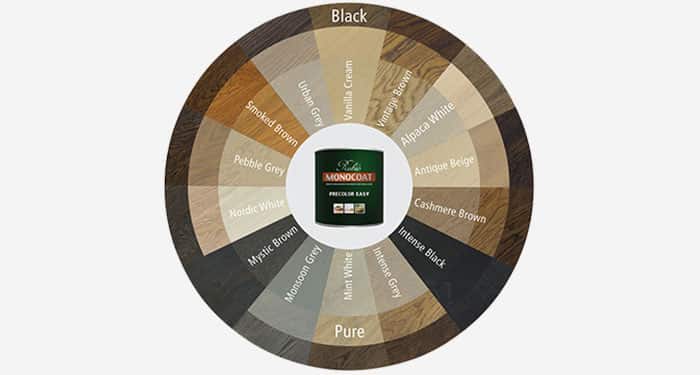
Basically it’s like a stain or dye that you apply to the wood before applying the Rubio Monocoat Oil Plus 2C. But, unlike normal stain, because its specially developed to be used with the Oil Plus 2C, the molecular bonding of the oil to the wood (as we talked about in this blog post) is still guaranteed.
By using both the Pre-Color Easy and the Oil Plus 2C together it allows you to come up with virtually endless possibilities of amazing and unique color combinations.
So let’s have a look at some of the colors that are possible.
To start with, here are the 14 stock Pre-Color Easy shades available straight out of the can…
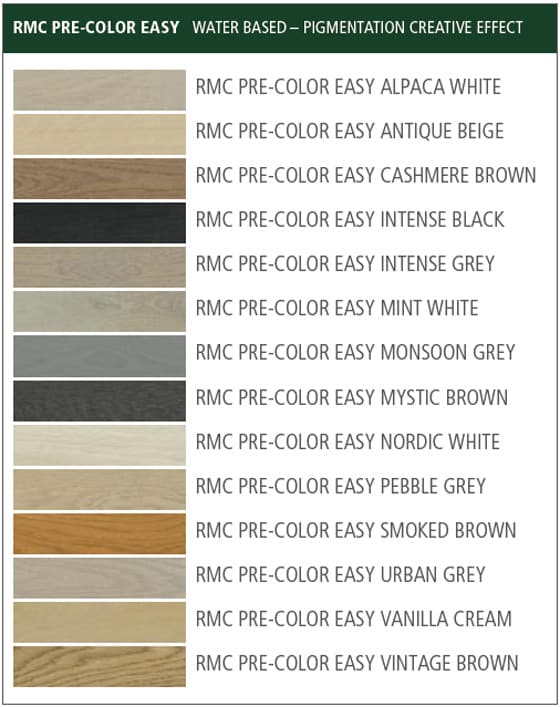
There are some very nice colors there. But you’re not just limited to what comes in the can.
You can mix any one of those 14 colors together to come up with whatever custom shade and color blend you like.
On top of that you can also use the colored Oil Plus 2C over the top of the pre-color treatment to give it an even deeper, richer custom look. In the chart below you get an idea of some of the cool colors that can be made with different variations of the colored Oil Plus 2C…
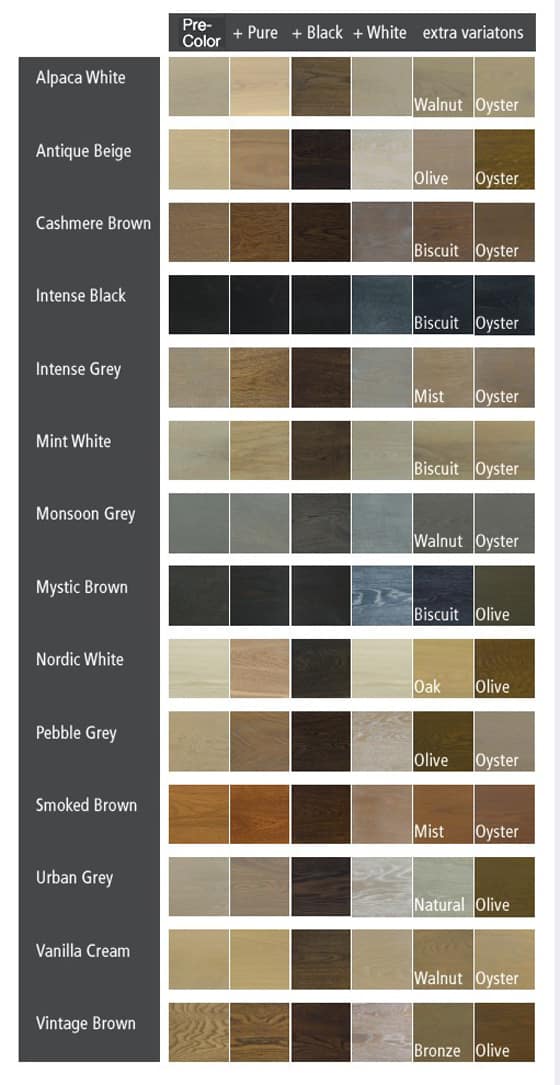
This chart shows what is possible with just 5 colors of Rubio Monocoat Oil Plus 2C. There are 40 colors in total, so you can imagine the unlimited creative possibilities that are available!
And if you want to stretch your creativity even further – all colours within the RMC Pre-Color Easy series can also be diluted with water to allow for even more lighter colored shades.
Can you see why we love this hardwax oil product so much?
RMC Pre-Color Easy Training Day
Last month we went to a Rubio Monocoat training day in Chicago to get caught up with the latest techniques in using RMC Pre-Color Easy. It was held by an extremely experienced hardwood floor coatings expert – Johannes Boonstra.
I have a lot of respect for Johannes so I’m very happy that he has joined the Rubio Monocoat team and I can call on him for expert advice when I have questions about their products.
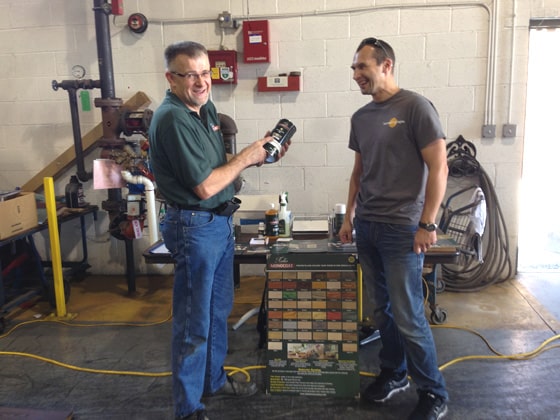
Below you can see him applying Pre-Color Easy Intense Black to an oak sample board…

As you can see it definitely is a very intense black color. If you want a really dark floor then this could be what you’ve been looking for.
Then below you can see the Oil Plus 2C being applied over the top of the Pre-Color Easy treatment…
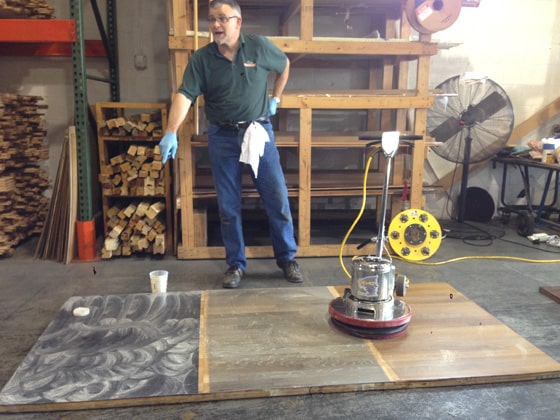
The color oil used was 5% White.
Unfortunately I forgot to take a picture of the finished sample board – I was having too much fun. But not too long after this class, we got to do a Mystic Brown + White Rubio Monocoat floor in Naperville. Not quite as dark as the Intense Black, but it will give you an idea of the effect…
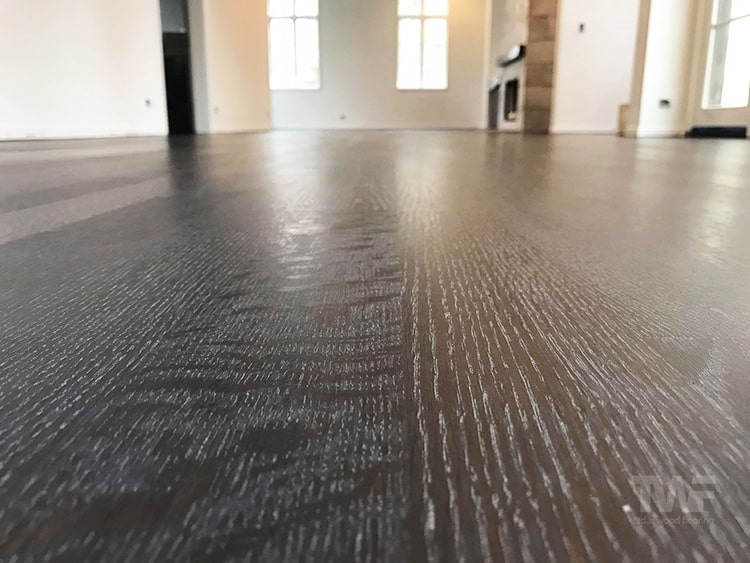
The other 2 colors on the board are the Fume treatment and the Smoke treatment which are different to the Pre-Color Easy treatment.
If you’ve read some of my other articles on this blog, you know I’m a big fan of Rubio Monocoat. Now, with this new pre-treatment and the creative possibilities it represents, I’m an even bigger fan. I love this product.
So, if you would like to have completely unique custom hardwood floors in your home, then give us a call and we’ll have some fun with color combinations from this line of Rubio Monocoat products together.
The hardest part will be deciding on a final color.
–
Updated Jan 2023


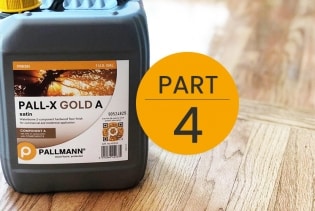
I have some old maple wood floors that I am in the process of sanding and refinishing. I was looking for a stain for maple wood flooring on the internet and came across your website. I would like to learn more about your Rubio Monocoat floor finishes and would like to know if this is a product that I could use on my maple floors.
Thanks.
Hi Adriane,
Yes it definitely can be used on maple floors. You can read more about this product on another blog post I wrote here:
https://napervillehardwood.com/blog/the-hardwax-oil-experiment-part-2-monocoat/
Tadas
Hello,
I wonder which Precolour Easy will darken the Natural Oil Finish PINE best into a rich reddish brown: Cashmere Brown or Vintage Brown or even Smoked Brown? I have to match new window frames to existing old frames…
Also, how can I remove fat stains from a floor treated/finished with Rubio Natural Oil Pure?
I live in River Forest, IL.
Thank you,
Mrs. Almut Roberts
Hi Mrs Roberts,
I would test a few colors out to ensure a good match. My first choice though would be Smoked Brown + Pure from your description.
For the stains in your floor, you will need to lightly sand the area until it is removed and then re-apply the oil. It is very important to know the sanding and application sequence the contractor used so the repair color matches the rest of the floor.
Since you are close by, feel free to give me a call if you need some help.
Tadas
Hi,
Have you done any Red Oak floors with the Rubio Precolor Easy yet? Anything to watch out for?
The Rubio rep suggested Precolor “Intense Grey” then “White” or “White 5%” oil to get the Fumed look (he did not recommend fuming red oak as it might turn many boards mildew green). The fumed look is too dark for me though. I am trying to get to that light brown/gray reclaimed wood color so I’m thinking the ‘Mint White’ Precolor might cancel the pink then apply the Biscuit or Havanna Monocoat Oil on top?
There are SO MANY of us out there with 2 1/4″ RED Oak floors that are trying to create the white oak weathered wood look and so little information on how to do this with Rubio (everything is on White Oak). I’m wondering if you’ve done any that have come out successfully?
Thanks!
Angela
Hi Angela,
I have done a lot of fuming on red oak and it works fine. Here’s the latest one:
It’s standard 2 1/4″ red oak, fumed and finished with Rubio Monocoat Super White 2c.
Red oak does react with fumed,but much less than white oak.
I just actually applied fumed on red oak a few hours ago. Tomorrow we will be applying the super white.
Tadas
I have wasted money on a number of precolor easy stains in the hopes of darkening the wood in the desired color tone before applying the oil plus 2c (which alone is not dark enough). If this company were smarter, they would replicate the stain colors that they have in the oils so customers could darken to their desired shade. Instead, Rubio monocoat provides a whole new set of colors, none of which work with the color tones of the oil 2c colors that I’m using. It’s bad enough that poor quality color swatches on the website look almost nothing like the real life color you get after application.
I also doubt that there is anything proprietary to the precolor stains and it just seems a business ploy to capture their customers’ spending on related products while then overcharging them for small quantities of what they can get elsewhere (locally) for reasonable prices. I would be willing to bet that any alcohol based dye stain would not affect the bonding adherence of the oil plus 2c to the wood base and early experiments seem to be bearing this out.
‘Proprietary’ verbiage rationalizes overcharging for precolor stains at $20+ dollars for 3.4 fl oz (100ml) or $80 for 1 liter. I can’t stand companies that pull this crap.
Hi J,
Sorry you’re having trouble getting the right color match. That is very frustrating and we’ve been there many times.
The point of these pre-colors though is to completely change the look of the floor color though, not to provide the same shade but darker. Did you water pop the floor before applying the oil? This is the best way to get a darker shade. It also makes the finish much stronger too. We water pop all our Rubio Monocoat floors.
Not sure about the proprietary of the pre-colors either but as most of our floors are in the multiple thousands of dollars range, spending a few extra dollars to ensure compatibility and adhesion is well worth it for us. Finish companies spend big bucks and a LOT of time to get their products right. Yes, we don’t like paying the prices we have to for high-end finishes either, but its better than the alternative of experimenting on 1,000+ squre feet and something going wrong. Then you’re in for a lot more time, money and stress.
For us it’s just part of business and we’re willing to pay for a sure thing for our clients vs some alternative that may or may not work.
Hope your floors turn out well for you.
Tadas
Hey Tadas,
Any recommendations for staining the interior of a timber framed home, made out of red pine? We are hoping to use Rubio Monocoat stain, our first trial run ended up a little blotchy.
Please help ( :
Shannon
Hi Shannon,
Sorry for the delay. Pine is notorious for being blotchy. Try water popping it first and see how that goes.
Tadas
I have 200-year-old wide board PINE floors in my house that I am refinishing. I have been experimenting with Oil Plus 2C. As close to natural/untreated, leaning toward white is the desired finish.
So far I have tried:
1. Pure/Clear: As expected, produces a yellow/amber finish.
2. White: Brings out the red streaks and imperfections in the wood.
3. Natural: This is closest to desired finish, but the tone is somewhat flesh colored.
Now, my thought is to apply one of the white stains (Nordic,Alpaca,Mint) first and then coat with Pure Oil.
Another reason that I am considering this method is that I have varied gaps between the boards and when I used the White or Natural Oil, the pigment would spill into the gaps. With the Precolor dye, I could apply with more care using a brush.
What are your thoughts on that?
Hi Roman,
Sounds like a good plan.
Tadas
I have made several slab tables and used Rubio monocoat and love this product , this time I have a walnut slab that my wife wants me to try adding or creating grey and black in it rather than the natural browns ? Does anyone have any input on this of what to use ??
Hi Mike,
Maybe start with the Intense Black + White and see how that looks.
Tadas
Please help! I love the Rubio product but am having a hard time getting a medium toned brown/gray. I have white oak flooring. I like the light to medium reclaimed look. I’ve tried mizing different oils. And tried some precolor. Don’t know what I’m doing wrong. Thank you!
Hi Julie,
Have you tried pre-color black with Monsoon Grey? Hope you can get the shade you like.
Tadas
Hi Tadas would love some advice from your expertise. I have already applied PCE and RMC oil on top without the 2C. Unfortunately I was told by the shop I bought the product from that I could apply PCE like a paint, very heavy with multiple coats to match by prefinished hardwood. Now that 30 days have gone by the finish is still susceptible to water and can smudge it if I rub it a bit with my thumb. I believe this is due to the excessive PCE. I am thinking that I will need to use a oil based topcoat (water based would remove the PCE) to seal in the application and make it durable. (I quite like the finish I achieved so I don’t want to redo) Any suggestions on product and application? Obviously based on using RMC I am looking for something very low VOC. Thanks for any help!
Hi Farooq,
The missing step was not using the accerator (2C). The PCE with multiple coats is fine. Best to maroon pad to open up the grain and put another coat on with the 2C this time.
Hope you can get it sorted.
Tadas
Hey,
You say you water pop all of your rubio monocoat floors and that it makes the finish “stronger”. In what ways does it make the finish stronger? Have you tested samples next to each other with the only difference being the water popping?
Thanks,
Zach
Hi Zach,
Water popping opens up the grain and allows the oil to penetrate deeper = a stronger, longer lasting finish.
Yes we have tested it.
Tadas
Hi Tadas
I am looking to treat ash wood with 5% mist…we have tried many variations of the Monocoat produsts. 1) Smoke seemed to have little impact on the ash but did raise the grain – one dealer told me that the smoke is really for white oak, 2)PCE products did not seem the color evenly as the ash has spots that do no absorb the color and the colors never matched the picture (got tried of buying samples).
So we think the water popping with the 5% mist will give us a nice finish…do we need to water pop and use the red buffering pad (does the red pad not open up the grain?) How long should we wait after water popping to apply oil?
Thanks for your help…
Hi Philip,
Yes I would water pop for sure. Allow it to thoroughly dry before applying it. Should only take an hour or so depending on the weather and humidity levels.
Tadas
Hello! Love you site and all the great info! I am having hardwood floors put in the bedrooms of my home and I want to use the Rubio Monocoat but i need it to match or flow with the existing floors throughout the home that are traditionally stained dark walnut oil. Any advice on what Rubio color combo will match or at least transition/flow from the existing floors? Thanks!!
Hi Janelle,
That’s a tough one for me to say without seeing the floor in person. I would say find a reputable flooring business and get them to make some samples for you. There is such a huge range of possible color combinations you should be able to get pretty close. Once you have a close match, get them to prep the new floors and apply the color next to the existing flooring, just to be sure.
Tadas
Hi Tadas,
Love your blog!
We have 4″ wide, flat sawn red oak floors. They are currently coated with RMC Vanilla, which we’ve gotten tired of. There’s kind of an orange undertone to the Vanilla that we should have anticipated but didn’t.
We’d like to accomplish three things with our next RMC floor: (1) quiet the grain of the red oak as much as possible and have an even color and tone across the floor; (2) eliminate as much of the pink undertones in the red oak as we can; (3) keep the floors very light but also natural, i.e., I don’t want them to look like they have white highlights. If I were building our house from scratch, I’d install rift sawn white oak floors, but alas, that’s not an option.
I’m getting ready to order a bunch of samples to try out but interested in your thoughts. I was thinking about trying one of the lighter precolors (Alpaca White, Nordic White or Mint White) followed by a lighter 2C color (Natural, Mist 5%, Corn Silk, DC Smoke or Smoke). What do you think? Would using the Smoke effect after the precolor and before the 2C help?
Thanks in advance!
Michael
Hi there, Tadas & Michael!
We are trying to achieve very similar goals with our red oak. Namely, quieting the grain and the pink undertones. That said, we might like ours just a bit whiter – more of a bleached scandi look. Just wondering if either of you have any suggestions, recipes, and/or outcome photos after using Alpaca White, Nordic White or Mint White.
Thanks so much for your assistance and advice.
Best!
Marty
Hi Michael,
You’re definitely on the right track, except I wouldn’t recommend using Smoke reactivate because it tends to fade and will loose the effect completely in some time.
Try out the colors above and see which is your favorite.
Hope it goes well!
Tadas
Hello,
We have some exposed, unfinished Douglas Fir beams in our house. These are just rough lumber needed for structural reasons. Everything else in our house is a light natural Color. These beams stand out due to the natural orangish red of the wood. What’s the best way to get the Red/Orange? We want them as light as possible almost like they’ve been bleached. I’ve tried the white, smoke and mist stains, but they still looked red, just with a white or grey film on them. What would you suggest? Should I precolor?
Hi Josiah,
Try Mint White or Nordic White and see how that looks. There’s also another product we’ll be testing out soon called Loba PreTone White:
https://www.loba.de/us/products/natural-oils-and-waxes/special-product/product/pretone-diverse-colors/
Looks promising for applications like yours.
Tadas
Hi- I have a maple wood slab that I am turning into a table. Do you have any recommendations?
Hi JB,
Make sure you water pop it first. After that the color choice is yours. Maybe do a few test with the sample kit to see what you like.
Tadas
I’m looking for some input on getting red oak stained a very dark brown/grey that doesn’t pull red hues. In your experience, is there a reasonable way to achieve this on red oak using the Monocoat system? Is using white oak going to be the better choice for achieving a color like this?
Hi Jared,
White oak will definitely be better.
If you have existing red oak, try pre-color easy Nordic White + Charcoal. Or a Charcoal/Chocolate mix.
Tadas
Hi! Have quite a problem on my hands. Ordered red oak parquet to match existing red oak parquet. Vendor sent white oak, and I didn’t notice until it was already installed and we started sanding it all. Now I need to try to get them to match as much as possible, while staying with as light a color as I can (ideally they’d match the white/red oak stairs we did in 5% Mist). Any suggestions? The red oak is quite pink:(
Hi Mandy,
This is a very common mistake we come across.
The best fix is to replace the wood with matching product. But this isn’t always an option. There is a new product available from Ciranova that can help somewhat with this…
https://www.pinkblocker.com/about
We haven’t tested it yet ourselves but it looks promising.
We have another option we’ve been testing but it’s complicated and not DIY friendly.
Hope you can get them sorted.
Tadas
Hi, really hoping you can help us — we thought we’d done some pretty thorough research on our latest Rubio project (we went with Bourbon for about 1500 sq ft of flooring). It turns out our existing flooring was white oak when we thought it was red. The new flooring we used to replace really damaged boards and for the kitchen — which is now open to the dining room — are red oak. We’ve finished the floors with one coat of Bourbon Oil Plus 2C last night. Results were what you would probably expect – not ok.
Rubio suggested re-sanding the red oak and applying Pre-color Easy in one of the browns, then reapplying the Bourbon, but it was very informally via chat. We’ve got plenty of Bourbon left.
I’m also considering just selecting a color that looks similar to Bourbon on White Oak and applying that to the red oak, but wanted to ask an expert who understands how the colors work and how to neutralize the red oak characteristics. On my computer, it looks like Olive, Savanna or Havana may be the best. Please let us know your thoughts. I’m surprised I couldn’t find an example of this scenario online, but maybe nobody makes this kind of mistake but us? Thank you so much in advance!!
Rebekah
Hi Rebekah,
Sounds like you have the same issue as Mandy in the comment above.
Again, I would recommend trying the new Ciranova Pink Blocker product if you can get your hands on some.
Take a few spare pieces of wood and do some tests. Use a few different colors, or mixes of colors/dilutions to get one that matches well. Make sure you are accurate in measuring the mix so you can replicate it again in a larger amount.
When you’re ready to do the floor, tape of the boards really well and let the Pink Blocker react and dry overnight. It should help neutralize the red oak. Then re-apply the custom mix of Rubio you used on your sample.
Hope you can get it looking good Rabekah.
Tadas
What pre color and oil +2c combo do you think would give German beech wood a dark chocolate finish?
Hi Bob,
Not too sure on Beech as we haven’t experimented with that, but I’d start with Antique Beige (or one of the Grey’s) and Black.
Tadas
I am sorry, I am very much a novice. My father and I are building a dining room table. We haven’t purchased the wood yet but I think we are going to use a white oak. I really like the way the grain is highlighted on the floors above in a light tone. Can that be done with one pre-color and one 2c?
I like the color of charcoal 2c but I’d like a little more grey to it. I may just stick to that since we are beginners. Still I thought I would ask.
Okay so if I want the look of that gorgeous video you posted for Angela above for red oak what I need to do is use just the Fumed first. Then just the super white over that after? Those are the only products I need to buy? Thanks so much.
Hi Layla,
Sorry for the delay. Yes all you need is Rubio Monocoat Fumed and the Super White oil.
Hope it goes well.
Tadas
Hi Tadas!
I’ve just come across your video. I am looking to achieve a black kitchen with rift wood veneer. The black on the oak looks too dark like a chalk board . My kitchen maker said I can have black or brown. Looking at your post it seems like I can have an off black? Or black brown? How would you achieve an off black and also a black brown for a contemporay rift wood veneer please then I can do the samples myself and show him :)) thanks Donna
Hi Donna,
Have a look at Project #21 here: https://napervillehardwood.com/photos-dark-stains.html
That is an black-brown looking floor. It’s Pre-Color Brown + 5% White. You could also try the opposite. Something like Nordic White pre-color and then Black.
Tadas
Hi! We just bought anew house with Brazilian cherry aka Jatoba. We are currently in the process of trying to figure out which stains we’d like to use.
We’d like to somewhat kill the red, so we’re willing to go very dark, however, my partner has made it very clear that they are not looking to making the floor black.
While they have not worked with Rubio Monocoat on Brazilian cherry, they did mention that the wood is very dense and that water popping Brazilian cherry is not ideal because it’s supposedly an oily wood. Can I ask what your thoughts are on that?
To kill the red a bit, should we just use a percentage of Intense Black? Does that mean diluting it with water? Or should we do a mix of a brown stain with Intense Black? Any suggestions on mixes or colour?
We’re not entirely sure about which colour for the Finishing Oil. What are your thoughts on which colour?
Hi Cathy,
You need to use Rubio Raw Wood Cleaner to prep the Brazilian Cherry first. As for color, you can use a mix of Pre-Color Easy (not stain) and Rubio Oil Plus 2C or just the Rubio oil. You will definitely want to do a few test samples first as the color goes on differently with BC vs oak flooring. Intense Black may look ok for what you are trying to do. That will turn out a dark brown. Charcoal would be a darker black shade. Don’t mix it with water, mix it with a lighter colored oil.
Tadas
Hi,
I’ve enjoyed reading your tips. Do you have one that might help me? I’ve used various Rubio Monocoat products on beautiful woods where I really wanted them to look natural (sapele, cherry, walnut, maple, etc.). Now I’m doing a simple red oak floor. I’ve tested many Rubio combinations and plan to use Pre-Aging #5 with Cinnamon Brown Oil plus 2c to match an existing upstairs floor. My question is this: is there a way to prep the wood that will help minimize the grain? Before discovering Rubio Monocoat I used aniline dye under stain to get a more uniform look on red oak. In my color tests with the Rubio products the color is perfect but the grain is accentuated.
Any sanding or pre-treating tips or ideas?
Thanks!
Hi Beth,
I can’t see why you couldn’t use aniline dye before applying Rubio (although I haven’t tested it myself so don’t take my word on it). Definitely don’t use stain as it will close the pores, but dye shouldn’t. As always, I’d do a couple of tests first. Rubio also have Precolor Easy and some of those colors will mute the grain. I wrote a blog post about that product here: https://napervillehardwood.com/blog/rubio-monocoat-pre-color-easy/
Tadas
I have some French white oak that I used a combination of Pure and 5% white a couple of years ago. I’m trying to match the color with some new unfinished French white oak flooring but the new wood is quite a bit lighter and leans towards a more peachy tone whereas the older wood leans towards green. I’m trying to figure out if I should use precolor (vintage brown or cashmere brown) or pre-age (authentic #4) then finish it off with Natural maybe a tinge of Pure. Which do you think is the better way to go Precolor or PreAge?
Thanks!
Hi Justine,
Hmmm… I would experiment with both but would probably start out with the pre-age. Will take a bit of experimenting to get it right. It’s one of the more tricky parts to this job. Hard to give advice without seeing the exact color and floor sorry. Hope you can find a mix that matches well.
Tadas
Hello Tadas,
We are interested in trying a few precolors with oil 2C on a 100 yr old door. Since different woods react differently and we don’t have samples other than the door itself, how easy is it to remove a test precolor in a small areas once we choose the final? Is it similar to Oil 2C itself, that is fairly light sanding could take off the color?
Thanks for sharing your experience and expertise with us.
Hi Chris,
Happy to help. Let the pre-color completely dry at least overnight, then it is pretty easy to sand and remove.
Tadas
Can the Rubio wax be applied over a red oak hardwood floor that was stained with Minwax Oil semi transparent color Jacobean (Dark Brown)?
Looking to cut down on fumes/smell, add an aged look to the floor with more of a flat mat finish, no gloss or yellowing, more environmentally friendly. DIY’ing ourselves would like to not have to rent a buffer if this is possible. Room size is 12 by 20. Any suggestions?
Hi Denise,
We don’t and Rubio won’t guarantee a floor that is coated over other products. You could apply a matte waterbased finish instead. Or go with Pallmann Magic Oil. Both are low VOC..
Tadas
Hello,
I purchased a few samples of the pre-color for my knotty pine kitchen cabinets. I liked the mint white color. I wanted to keep the cabinets the lightest shade of brown that is possible. What options would you suggest for the 2c color?
Hi Andrea,
I would try the Pure color. That will keep it in the browns, as light as possible. Make sure to test a sample area first :)
Tadas
Our solid poplar doors and trim still have orange undertones. Is there a Rubio product we can apply for a richer brown color? Do we have to strip the finish before applying if there is?
Hi Tracy,
Since words like ‘richer brown’ is so subjective it’s best to get a few samples and find the perfect shade for you. With Pre Color Easy and the colored oils, you have almost unlimited combinations. You can start with a lighter Pre Color Easy shade and a darker oil, or do the opposite for a different look. And yes, you definitely need to strip the finish and sand down to the raw wood first.
Tadas
I’m sanding and re-staining a knotty pine paneling wall. I’ve mixed Antique Beige and Cashmere Brown Precolor Easy to create a soft taupe color. However, it’s just a tad too plum (purple). I have several questions:
1) Do you have any suggestions for an Oil Plus 2C color to help tone down the purple without making the stain any darker?
2) Is there a clear 2C color that doesn’t change the Precolor color at all?
3) If there isn’t a clear 2C color then can Precolor Easy be topcoated with another water-based polyurethane?
Thanks for your advice, and great site.
I’m refinishing an old red oak dining table and am looking for suggestions on Rubio Monocoat colors. I’d like a medium brown table, similar to the pre color easy cashmere brown that is shown on their website on white oak. I can’t find a red oak sample. I would also like to hide the grain in the table as much as possible. Do you have any suggestions on how to achieve that?
Hi Liz,
We haven’t done this color on Red Oak either sorry. But if you go to this page they have Red oak color samples you can choose from:
https://www.rubiomonocoatusa.com/pages/oil-plus-2c-colors
As far as hiding the grain, this will be near impossible with an oak floor, Especially with a light color like you are looking at. Even when we do triple black floors, you can still see the oak grain showing through. The only option would be to paint the table if you want a light color, and even then, you would see the grain, just not the color.
Tadas
Hi Tadas
I’m not sure if you have dealt with this yet in another post. I have a surface that I had sanded to 180. We have gone the route of Pre-Color Intense Black followed by a Charcoal oil 2c. I didn’t realize till after the Rubio Oil 2c that the water based pre-color had popped my wood a bit more than we wanted. I believe I had read on another blog that the pre-color can be applied on top of the Rubio oil 2c to add some darker color. I think it has to be followed by a sealer of some sort I’m sure like a Rubio Nano3 product but I may not have that all right.
Can I run a light pass over the surface with say a 340 grit or higher just to knock down the popped grain a bit then run a light pass over with the Pre-color to re-color any of the newly exposed grain then seal with the Nano3 ?
or is there a better way to do this?
Hi Jeff,
No, unfortunately Pre-Color Easy won’t be able to be applied on top of Rubio Oil. Pre-Color Easy is water based and needs to go on top of raw wood, and then the Rubio oil on top of it.
The color most likely didn’t turn out as you wanted because 180 grit sandpaper you used is too high. 100 or 120 grit is what we use. That will give you a better and deeper color as the PCE will be able to penetrate the wood more. The higher the sanding grit, the smoother the surface and the more the pores are closed off, resulting in less product penetration and a lighter color.
If this was a project we were asked to consider, we would suggest a re-sand and starting over if you really don’t like to look of it. That’s the only way to do it properly. Sorry for the bad news.
Tadas
We are about to refinish a Brazilian cherry floor in a restaurant. I did these floors just three years ago with Bona traffic water-based polyurethane, and they just have not held up well. Would an oil finish like Rubio, or magic oil work on Brazilian cherry? And will it hold up better under commercial traffic than the Bona traffic did?
Hi Mike,
I would recommend Pallmann Magic Oil in this situation. Will hold up and look better than Bona Traffic over time. Water pop the floor first to get maximum strength and durability. You’ll be able to clean and then recoat it as needed. It’s a great option for commercial hardwood floors.
Tadas